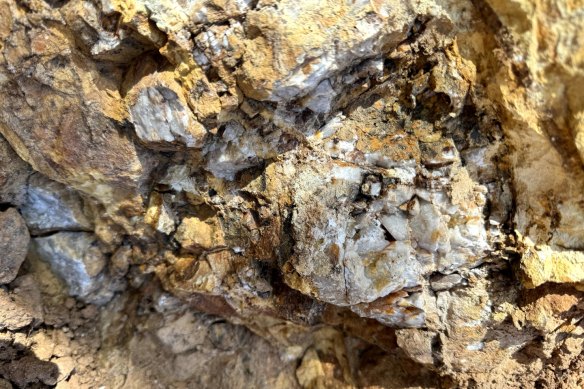
Dart Mining is continuing to build faith in its gold mineral system model at the historic Rushworth project in Victoria, recording more shallow high-grade gold in diamond drilling at its Star of the West prospect.
The company has today revealed a new find of 1.2m at 4.5 grams per tonne gold from just 19.9m downhole at the site that sits some 60km north-east of Bendigo. It says phase-two drilling continued to return high-grade gold at Star of the West within the targeted Shellback Reef structures – an east-west-trending, steeply-dipping fault between the target and its Growlers Hill prospect.

Dart Mining has revealed a new high-grade gold hit at its historic Rushworth project in Victoria.
Dart reports that the shallow gold-in-sulphide zone includes pyrite, cubic pyrrhotite and acicular arsenopyrite and intersects a steep south-dipping thrust fault structure that is surrounded by apparent sulphide mineralisation, forming the halo of gold results. The company believes the dominance of acicular arsenopyrite and fine-grained pyrite are recognised characteristics of sulphide mineralisation at Agnico Eagle’s nearby Fosterville Gold Mine, which is one of Australia’s most profitable pure gold mines and lies about 25km east of Bendigo.
‘Each drillhole has consistently returned positive gold grades, reinforcing the potential of these identified structures.’
Dart Mining chairman James Chirnside
Management says the latest drilling further validates its internal gold structures model, prompting more drill-testing across the goldfield. It is a field the company says has shown shallow historic development and has had only limited previous deeper drill-testing.
Dart Mining chairman James Chirnside said: “Dart’s drilling activities at Rushworth continue to be successful. By leveraging our advanced mineral systems model and in-depth structural analysis, we have effectively pinpointed highly-prospective targets. Each drillhole has consistently returned positive gold grades, reinforcing the potential of these identified structures.”
The Rushworth goldfield is focused along a series of regional east-west-orientated anticline folds that host shallow historic gold workings along a cumulative strike length of about 14km, including Dart’s Growlers prospect.
Interestingly, the east-west orientation of the field is unusual for the Victorian goldfields, which usually trends north-south. The reason the Rushworth region has added structural complexity is that it is highly-influenced by the Lachlan orocline further to the north – perhaps a reason why it has never been effectively drill-tested.
The company’s new interpretation suggests that the stacked gold reefs may also plunge southwards. The understandings arising from the phase-two drilling program will assist Dart in its phase-three testing that has already begun.









 Add Category
Add Category